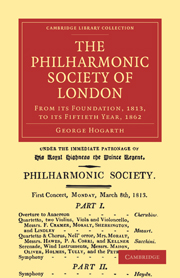Book contents
The Philharmonic Society
Published online by Cambridge University Press: 29 August 2010
Summary
The Philharmonic Society of London was founded in the year 1813. It was projected by a small number of eminent professional musicians, with the view of promoting the cultivation of instrumental–and especially orchestral–music, which, in this country, had not received due attention, and was not in a condition corresponding to the generally advanced state of the Musical Art. The immortal symphonies of Haydn (some of them composed and first performed in London), those of Mozart, several of those of Beethoven, and a large body of the Quartets and other concerted instrumental music of the same great masters, had long been given to the world; but they were known to and appreciated only by musicians and amateurs (then a narrow circle), while they remained nearly a sealed book to the public, who were almost destitute of the means of hearing and acquiring a taste for them. Twenty years before, there was a promise of progress, when Haydn, brought expressly two several times from Vienna for that purpose, composed his twelve “Grand Symphonies” for Salomon's Concerts, and when they were performed in Hanover Square to applauding audiences. But the impulse to public taste given by that spirited impresario was not followed up, and Haydn's symphonies were heard no longer.
At the period when the Philharmonic Society was projected, there was not in London any orchestra formed for, and capable of, the performance of what is properly called orchestral music; – music, that is, intended to produce its effect wholly by the combination of instruments, independently of any connection with the voice.
- Type
- Chapter
- Information
- The Philharmonic Society of LondonFrom its Foundation, 1813, to its Fiftieth Year, 1862, pp. 1 - 122Publisher: Cambridge University PressPrint publication year: 2009First published in: 1862



